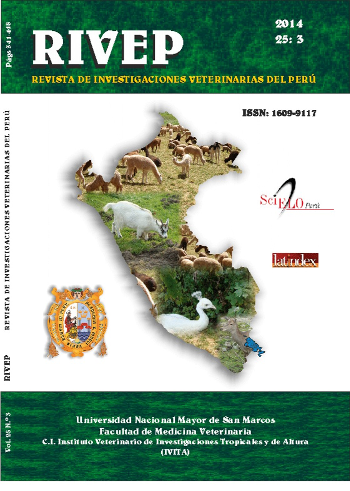ESTIMATED POPULATION OF STRAY DOGS IN THE DISTRICT OF LOS OLIVOS, LIMA, PERU
DOI:
https://doi.org/10.15381/rivep.v25i3.10114Keywords:
stray dogs, Los Olivos, zoonosis, bitesAbstract
The aim of this study was to estimate and characterize the stray dog population in Los Olivos district, Lima, during the period November - December 2012. Eight of the 34 areas that comprise the district according the map of Los Olivos Municipality were selected. The selection of the areas was at random; dog population counting and calculations were based on the criteria outlined in the guide of the World Society for the Protection of Animals entitled «Recensusing roaming dog populations: guidelines on methodology». Three consecutive sampling were performed at daytime and evening hours in each area. The average of the three measurements was used for statistical calculations. There was an average of 332 stray dogs at daytime and 217 stray dogs at evening; males and bigger dogs were observed in higher number. Most of the dogs showed low body condition score. The estimated number of stray dogs in the district was 1411 ± 643 at daytime and 922 ± 497 at night. Results are expected to contribute with the dog control population programme that is being implemented by the Municipality of Los Olivos.Downloads
Downloads
Published
Issue
Section
License
Copyright (c) 2014 Yaliní Ochoa A., Néstor Falcón P., José Zuazo R., Beder Guevara P.

This work is licensed under a Creative Commons Attribution-NonCommercial-ShareAlike 4.0 International License.
AUTHORS RETAIN THEIR RIGHTS:
a. Authors retain their trade mark rights and patent, and also on any process or procedure described in the article.
b. Authors retain their right to share, copy, distribute, perform and publicly communicate their article (eg, to place their article in an institutional repository or publish it in a book), with an acknowledgment of its initial publication in the Revista de Investigaciones Veterinarias del Perú (RIVEP).
c. Authors retain theirs right to make a subsequent publication of their work, to use the article or any part thereof (eg a compilation of his papers, lecture notes, thesis, or a book), always indicating the source of publication (the originator of the work, journal, volume, number and date).










